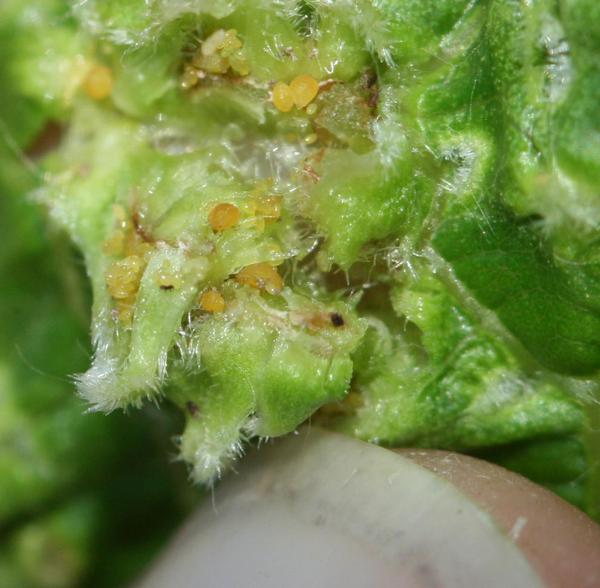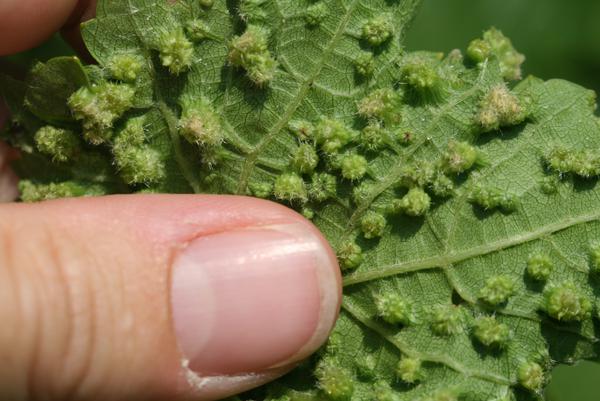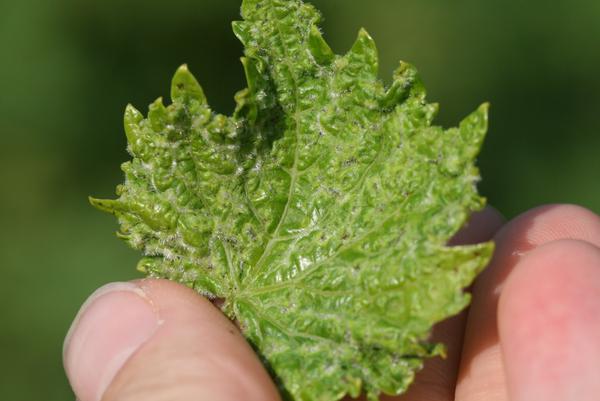Biology
Grape phylloxera (Daktulosphaira vitifoliae) is an aphid-like insect which can feed on both leaves and roots of grape vines. The life cycle of the grape phylloxera is complex and differs by location. In varietals hybrids between European (Vitis vinifera) and native North American grapes, the leaf-feeding forms predominate. In V. vinifera, the root-feeding forms predominate. Newly-hatched phylloxera are mobile “crawlers” that move around on the plant finding places to feed. Once they find a place to feed, female phylloxera become sedentary and excrete chemicals that cause the plant to grow protective galls around them. Female grape phylloxera grow, develop into adults, and reproduce inside the galls.
In North Carolina, foliar-feeding grape phylloxera have 3-4 generations per year. They can reproduce on both wild and cultivated grapes. As the grape phylloxera is native to North America, wild grapes and domestic cultivars derived from North American species are fairly resistant to grape phylloxera.
Damage in North Carolina Grapes
Leaf-feeding phylloxeras form distinctive wart-like galls on the leaves. These leaf feeding forms are the primary ones observed in North Carolina. Foliar infestations of grape phylloxera can be common in NC, but they are usually limited to a few galled leaves and do not impact photosynthesis. Occasionally, larger outbreaks occur in European-American hybrid grapes (Vidal, Seyval, Chambourcin, etc). Severe infestations can reduce photosynthesis, therefore decreasing fruit quality and vine vigor.
Root-feeding phylloxeras form galls on the roots which can lead to fungal infection and root girdling. In North Carolina, root-feeding phylloxeras are rarely a problem, due to widespread control through resistant root stocks. Muscadine and Concord/fox (Vitis lubrusca) grapes have little to no susceptibility to root or leaf damage from phylloxeras.
Sampling and Thresholds
No economic thresholds exists for grape phylloxera in North Carolina. Susceptible varieties should be checked for crawlers and galls in the spring as the leaves unfold.
Management Options
Cultural Control Methods
Most grapes in North Carolina are grafted onto phylloxera-resistant rootstock which provides protection against damage from root-feeding forms. Muscadine and fox grapes are highly resistant to leaf-feeding phylloxera. In general, grapes that are not American-European hybrids rarely have problems with leaf-feeding phylloxera. For susceptible varieties, if only a few galls are present, removing the affected leaves before the galls spread can effectively limit an infestation.
Conventional Insecticides
Refer to the North Carolina Agricultural Chemicals Manual for the most current recommendations on materials for grape root borer. Pesticide toxicity information for honeybees is also available in the North Carolina Agricultural Chemicals Manual.
The crawlers are most susceptible to insecticide applications. Pesticides have some efficacy against sedentary phylloxera before their galls close completely. Once the phylloxera are encased in galls, they are protected from foliar insecticide applications, so applications must be carefully timed to be effective.
Two conventional insecticides are labeled for use against grape phylloxera, acetamiprid (Assail 30SG) and spirotetramat (Movento 2 SC). These materials have some systemic activity and may also affect the phylloxera within galls. Both materials have similar efficacy and should be applied when crawlers are observed.
Organic Insecticides
There are no organically-acceptable insecticides that are effective against the grape vine borer. Organic growers must rely on cultural control methods.
More Information
More Information
The Southern Region Small Fruit Consortium Bunch Grape IPM Guide contains regional recommendations for grape phylloxera management.
Grape Phylloxera on the NC Small Fruit & Specialty Crop IPM Blog.
Publication date: April 20, 2020
The use of brand names in this publication does not imply endorsement by NC State University or N.C. A&T State University of the products or services named nor discrimination against similar products or services not mentioned.
N.C. Cooperative Extension prohibits discrimination and harassment regardless of age, color, disability, family and marital status, gender identity, national origin, political beliefs, race, religion, sex (including pregnancy), sexual orientation and veteran status.




